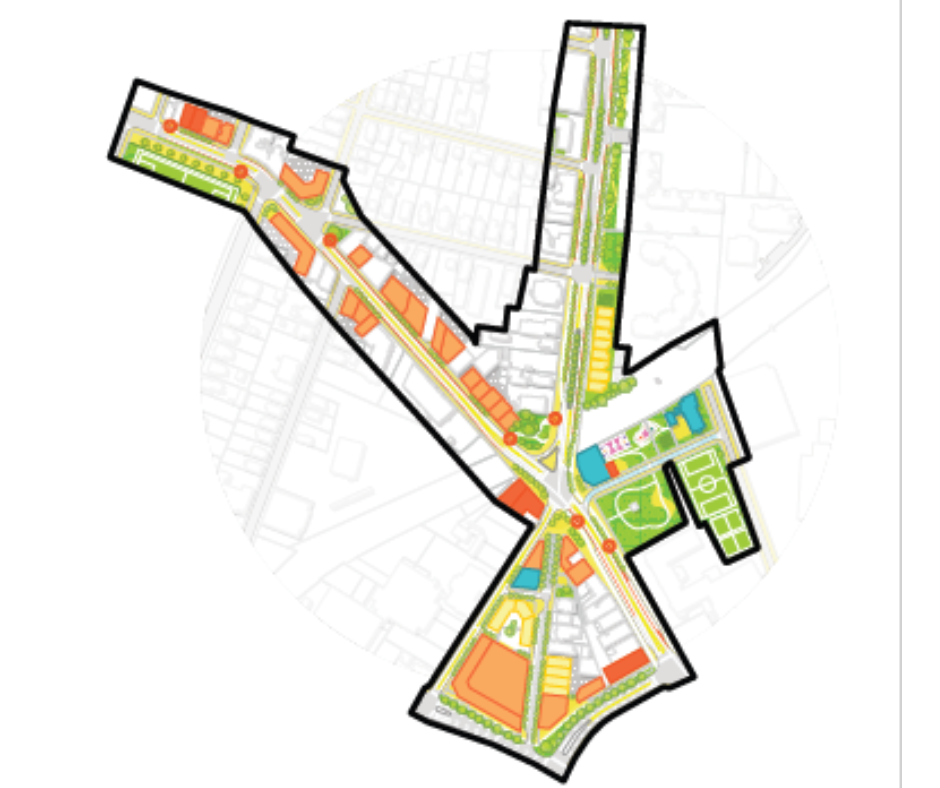The Arrowhead Gateway Small Area Plan and Corridor Study lays out a robust, community-focused framework to transform the Arrowhead Gateway neighborhood in Hartford, Connecticut, into a vibrant, inclusive, and economically thriving area. This plan, developed in collaboration with local residents, community leaders, and stakeholders, outlines projects, policies, and strategies to address the area’s pressing challenges while leveraging its strengths.
Vision and Purpose
The plan envisions the Arrowhead Gateway as a welcoming and dynamic neighborhood that acts as a gateway between Hartford’s Promise Zone Neighborhoods. Through a mix of community-focused goals, public realm improvements, and economic initiatives, the Arrowhead Gateway aims to foster a safe, accessible, and interconnected environment that reflects its cultural diversity and historical legacy.
Core Goals and Recommendations:
- Creating a Sense of Place and Community Identity:
- Establishing a Gateway: The Arrowhead Gateway will serve as an inviting threshold to Downtown Hartford, distinguished by cultural landmarks, historical preservation, and community spaces.
- Reflecting Cultural Heritage: Plans to honor the neighborhood’s rich history include celebrating diverse cultural contributions and maintaining historical architecture, creating a sense of pride and place that attracts visitors and supports community cohesion.
- Supporting Local Business Development:
- Focus on Small and Locally Owned Businesses: Economic support will be provided through technical assistance and financial resources for existing and emerging small businesses.
- Encouraging Entrepreneurial Growth: Affordable retail spaces and training programs are recommended to support local entrepreneurs and create a diverse economic landscape with retail, dining, and services that meet community needs.
- Pop-Up Events and Marketplaces: Utilizing vacant spaces for temporary events, such as food truck rodeos, artisan markets, and block parties, can help local businesses thrive and foster community engagement.
- Promoting Housing Affordability and Stability:
- Affordable Homeownership: The plan emphasizes affordable housing strategies to support existing residents, prevent displacement, and attract new residents. Programs aim to increase homeownership rates and offer diverse housing options, from apartments to townhomes.
- Mixed-Income Housing Development: Expanding affordable and market-rate housing is key to creating a more inclusive and economically diverse community. The plan also prioritizes housing designs that complement the neighborhood’s architectural character.
- Enhancing Connectivity and Infrastructure:
- Transportation Accessibility: Improvements to pedestrian, bicycle, and public transportation infrastructure are central to making the Arrowhead Gateway a more walkable and accessible area. Enhancements include widening sidewalks, adding high-visibility crosswalks, and introducing protected bike lanes.
- Redesigning the Main/Albany Intersection: This critical intersection, which connects the Gateway to other neighborhoods, is targeted for a redesign to improve safety for pedestrians, cyclists, and vehicles.
- Public Transit Enhancements: By adding bus shelters, benches, and other transit amenities, the plan aims to make public transportation more comfortable and accessible, especially for residents without personal vehicles.
- Addressing Health and Food Access Needs:
- Healthy Food Access and Grocery Options: The neighborhood’s limited access to affordable, healthy food options is a priority. The plan proposes the addition of a full-service grocery store and healthier convenience options at existing markets.
- Health and Wellness Initiatives: Community spaces dedicated to health and wellness, such as fitness areas, social services, and mental health resources, are encouraged to promote overall well-being.
- Activating Public Spaces and Placemaking:
- Revitalizing Keney Tower Park: As a prominent local landmark, Keney Tower Park will be revitalized with new amenities, events, and landscaping to enhance its role as a community hub.
- Green Spaces and Recreation: The plan advocates for increased green spaces, such as playgrounds, sports courts, and community gardens. New gathering spaces aim to provide residents with areas for relaxation, recreation, and socializing, contributing to the neighborhood’s quality of life.
- Implementing Placemaking Projects: Initiatives include establishing community art installations, historical monuments, and vibrant street landscapes that celebrate the neighborhood’s heritage while creating an engaging environment for residents and visitors.

